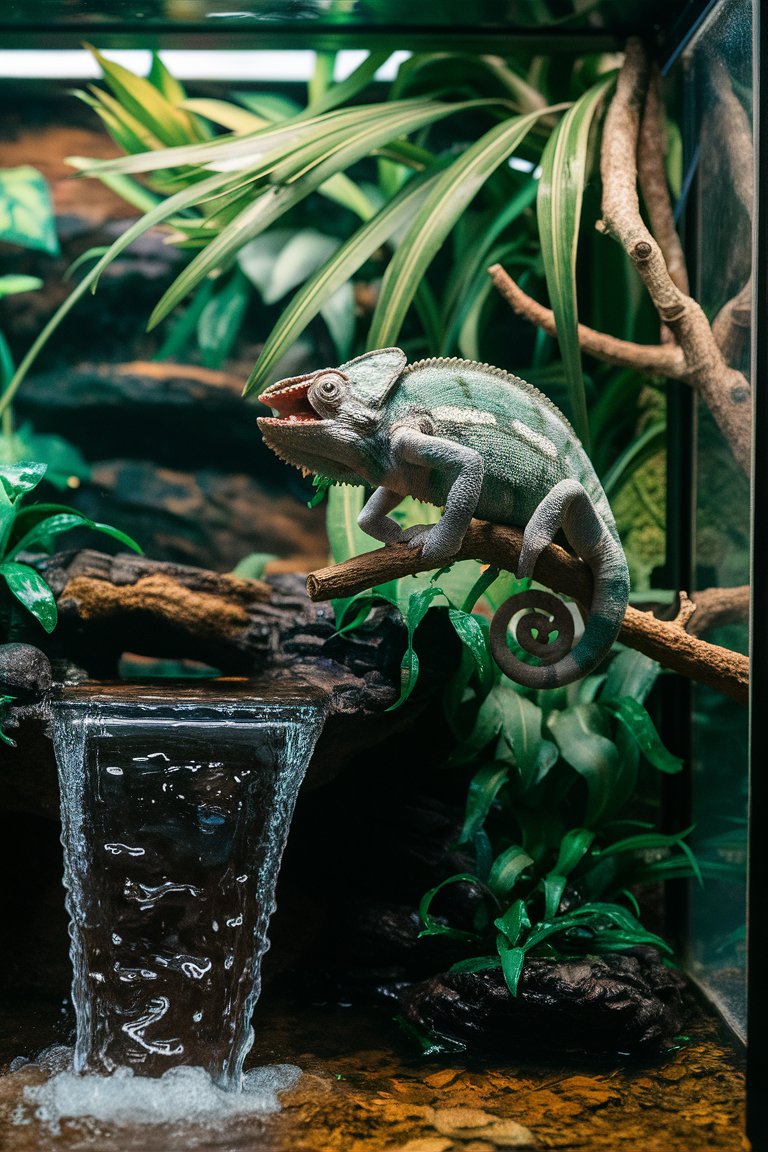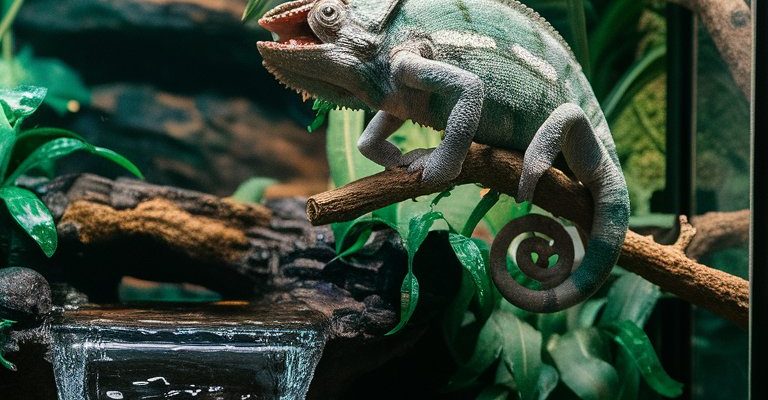
Imagine your chameleon perched on a branch, basking under warm light, surrounded by lush greenery—it sounds cozy, right? But achieving this requires thoughtful planning and the right materials. Key factors include the size of the enclosure, appropriate heating and lighting, humidity management, and decoration. Let me explain how to pull this all together step by step so you can create a safe haven for your veiled chameleon.
Choosing the Right Enclosure Size
When it comes to veiled chameleons, size really does matter. A larger enclosure not only gives them room to roam but also allows for better air circulation, which is crucial. Ideally, you want a tall terrarium because chameleons love to climb. A good starting point is a 24x24x48 inch (or larger) enclosure. This setup will give them plenty of vertical space to explore and bask.
Here’s the thing: if you’re planning to keep more than one chameleon, or even if you just want to ensure your pet has plenty of room to thrive, bigger is usually better. You might be tempted to go with a smaller tank for convenience, but remember: chameleons can get stressed in cramped spaces. More room means they can exhibit more natural behaviors.
Don’t forget, a screen enclosure is a smart choice! It not only provides good ventilation but also mimics the natural environment better than solid glass or plastic tanks. So, keep that in mind as you shop around for the best enclosure setup for your veiled chameleon.
Heating and Lighting Essentials
You might be wondering what kind of heat and light your chameleon will need to feel at home. Just like we need sunlight to stay healthy, veiled chameleons thrive under specific lighting. They need a basking spot with a temperature around 85°F to 95°F (29°C to 35°C) and a cooler area that ranges from 70°F to 80°F (21°C to 27°C).
To achieve this, you’ll want a combination of a basking lamp and UVB lighting. A basking bulb provides the heat, while a UVB lamp is crucial for their calcium absorption. Without it, chameleons can develop serious health issues. Make sure the UVB light is on for about 10-12 hours a day—just like a natural day-night cycle.
Don’t forget to position the lights correctly! The basking area should be directly under the heat lamp, but it’s essential to create a gradient in the enclosure. This way, your chameleon can move to cooler areas when it needs to. And definitely invest in a thermometer to monitor those temperatures!
Humidity Levels: Keeping it Just Right
Maintaining the right humidity level is one of those things that can make or break your chameleon’s health. They thrive in humidity levels of about 40% to 70%. To keep things in check, you might want to invest in a hygrometer—a handy little device that measures humidity inside the enclosure.
One effective way to achieve proper humidity is through regular misting. You can do this by hand with a spray bottle or, for more convenience, set up an automatic misting system. These systems can be programmed to mist at specific intervals, ensuring your chameleon gets the moisture it needs without you having to think about it constantly.
Another tip? Adding live plants to the enclosure can help maintain humidity levels. Plants not only look great but also provide hiding spots and climbing opportunities for your chameleon. Just make sure any plants you choose are safe for them!
Decor and Climbing Structures
Adding decor to your chameleon’s enclosure isn’t just about aesthetics; it’s about creating a stimulating environment for them. Think of it as building an adventure park! Chameleons are natural climbers, so providing plenty of branches and vines will encourage exercise and reduce stress.
You can use natural branches from outside, but make sure to sanitize them to prevent any unwanted pests or bacteria. Alternatively, you can purchase climbing structures from pet stores designed specifically for chameleons. These usually come with various platforms and hides.
Adding live or artificial plants also contributes to a more natural feel. Live plants can help with humidity and provide shade, but make sure they’re non-toxic. If live plants seem too much to manage, high-quality artificial plants work just fine and are easier to clean.
Also, don’t forget to create hiding spots! Chameleons can be shy creatures, so providing areas where they can hide will help reduce stress. Small caves or dense foliage work great for this.
Feeding Station and Water Source
Setting up a reliable feeding station is essential in the best enclosure setup for your veiled chameleon. These guys have a unique way of eating—they’ll be on the lookout for their food, typically insects, and will appreciate a designated spot to catch their meals. You can place a shallow dish in a corner for their food, but be careful it’s not too deep, as chameleons prefer to snatch food directly.
You can feed your chameleon a variety of insects like crickets, mealworms, and roaches. It’s a good practice to dust these insects with calcium and vitamin supplements to keep your chameleon healthy. Just remember to remove uneaten food to prevent stress and mess.
For drinking water, misting the enclosure will provide moisture on leaves for them to drink from. Chameleons often prefer to drink raindrops off leaves rather than standing water. So, if you can, create a gentle misting routine that encourages them to hydrate naturally.
Regular Maintenance and Cleaning
Keeping your chameleon’s enclosure clean is just as vital as setting it up correctly. Over time, waste from uneaten food and droppings can pile up, leading to potential health issues for your pet. A good rule of thumb is to spot clean daily and perform a deep clean every couple of weeks.
During spot cleaning, remove any uneaten insects and droppings. For deeper cleaning, take out all substrate, decorations, and plants, and wipe down the surfaces with a reptile-safe disinfectant. Rinse everything thoroughly to ensure no residue is left behind.
You might also want to check the lights and heating equipment regularly to make sure they’re functioning correctly. The last thing you want is for your chameleon to get overheated or too cold because of a burned-out bulb.
Final Considerations for a Happy Chameleon
Setting up the best enclosure for your veiled chameleon can seem overwhelming, but breaking it down into manageable steps makes it easier. Remember, this is not just an enclosure; it’s your chameleon’s home. Take your time to make it comfortable and suited to their needs.
Think about how each element—size, temperature, humidity, decor, and cleaning—plays a role in your chameleon’s overall well-being. It’s crucial to observe your chameleon’s behavior after making any changes. They’ll often tell you if they’re happy with their environment or if something feels off.
The more you learn about their needs and preferences, the better you’ll be at providing a safe and enriching home. So, grab a cup of coffee, take a deep breath, and enjoy this rewarding journey with your veiled chameleon. A little effort goes a long way toward a happy, healthy pet!

